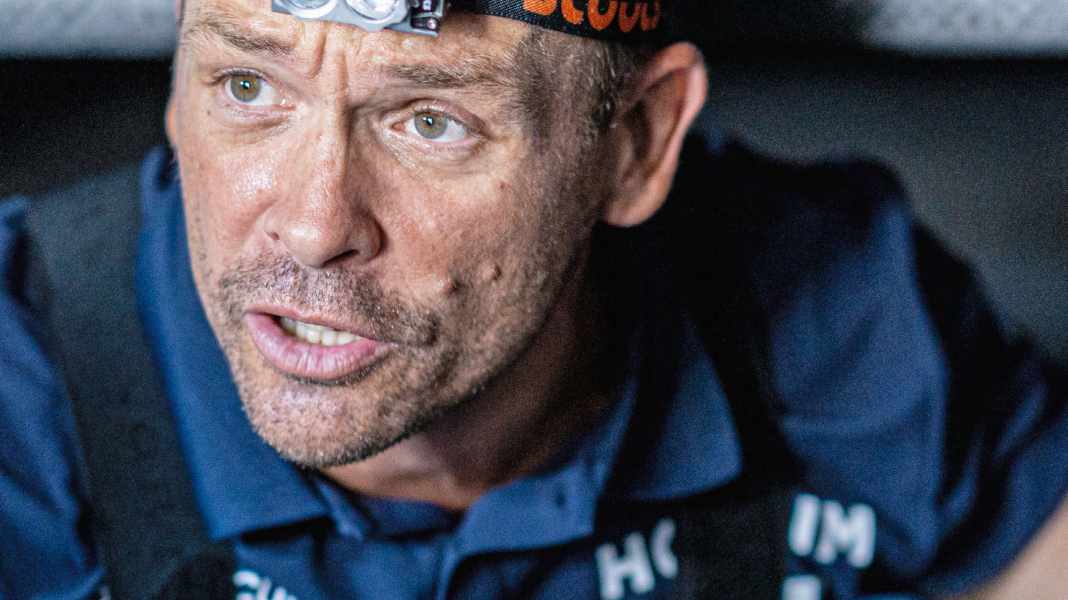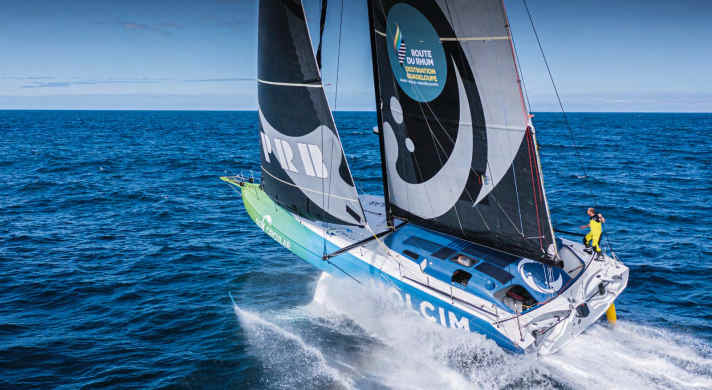
In a good mood, as always, we catch Escoffier on the phone after a short holiday in the Caribbean following the Route du Rhum. The Frenchman is on his way to Alicante, where he and his crew are preparing for the start.
YACHT: Kevin, what are you taking away from the Route du Rhum for the Ocean Race? How is your new "Holcim - PRB" sailing?
Escoffier: The boat was easy to sail, that was our goal and is important for single-handed racing. We were always close to the three fastest boats. So we don't have a speed problem, which is very good. And we really had a lot of different conditions. For me, it was the perfect comeback to single-handed sailing. I hadn't sailed my own boat for two years after the sinking of "PRB" during the Vendée Globe. This gave me confidence in the boat and gave me the self-assurance that we could be at the front.
How did it feel to sail alone into a storm front again at night?
That wasn't a problem at all. Accidents like that are just part of the game for us. I was more worried that I was a bit rusty after a two-year break and that I wouldn't be able to sail the boat at the top level again straight away. There is certainly still a lot to learn. But the Ocean Race is very good for that. Because of the tight schedule, we are starting with a boat that we are getting to know better and better. We will be faster every leg.
Are there any lessons learnt from the demise of "PRB" that have been incorporated into "Holcim"?
We have made a few changes in terms of safety. The life raft's drift anchor has been changed so that it doesn't roll over so often in rough seas. There is now a marine radio with AIS in the island, not just in the emergency bag. I couldn't take it with me at the time, which made it impossible to speak to Jean Le Cam, who rescued me. And there is now a radar reflector attached to the top of the life raft.
We also adjusted the calculations for the structure of the "Holcim - PRB" with the designer. Normally, the foil pushes the boat out of the water in the centre, thus reducing the pressure on the front part. When my old "PRB" drilled very deeply into the shaft, we suspect that this was reversed: The foil pushed the hull down and increased the load on the bow so enormously that the hull broke. We have therefore significantly reinforced the front.
Is participation in the Ocean Race an advantage for the Vendée Globe?
Many skippers decided against it ... That is also a financial question. The Ocean Race is very expensive compared to the other regattas. It's not just the skipper who decides, but above all the sponsor. These are often French companies that are not necessarily looking for the international market. I am a classic example of this: PRB would not have sailed the Ocean Race as a sponsor, but as the company was bought by the Holcim Group, which operates internationally, they were very interested in the race around the world. I think it's also good preparation. You don't have many opportunities to sail the boats off the Vendée in the Southern Ocean and make them fast. We can now push hard for 30, 35 days, which we would otherwise never do in the French races. That's good for the reliability of the boat.

There are those who question whether an Imoca can cope with the strain, because the boats are usually only loaded up to 80 or 85 per cent single-handed in the Vendée, but 100 per cent in the Ocean Race. Is that a problem?
We will soon get the answer to this question. But we certainly have to be careful. The boats are even faster with the new large foils. In the second cold front on the Route du Rhum, we were easily able to log 25 knots with a wind angle of 55 to 65 degrees. When you're travelling at such speeds in four or five metres of swell, you need to look very carefully at the structure. You actually have to sail these boats like multihulls: The swell determines the speed. Even the load sensors don't help much. A single wave is enough to break the boat.
Charlie Enright's team was the first to start preparing for the Ocean Race. How big is 11th Hour Racing's lead over the others?
It's a huge advantage. Their boat is also a Verdier design of the latest generation, just like ours. And they have been training for many months with the crew sailing the Ocean Race. My crew and I haven't sailed together for two days yet. But we have sailed a lot towards 11th Hour here in Brittany, where they have been training. I think it's our turn. The first leg will show us exactly where we stand. But the reliability of the boat is also a big factor.
How do you like the new route?
We know it very well, it's actually a Vendée Globe in small stages. Ultimately, the route doesn't matter to me. I'm a regatta sailor, the battle with the opponent is the important thing. I'm not sailing the Ocean Race as preparation for the Vendée, I want to win it again!
There are only two skippers with Volvo experience at the start of the Ocean Race, Charlie Enright and you. Does that count?
Not really, the others are also very good, experienced sailors. It's an advantage if you start preparing long before the race. We only decided to do this in July.
Is the Ocean Race with Imocas tactically different from the Volvo 65?
The boat types have changed again and again over the years, so it makes no sense to draw comparisons. What is true is that the race is different now. We sail the boats with only four crew members (anda media officer (editor's note).This means we are travelling a lot under autopilot. This also changes the way we drive manoeuvres.
There was no autopilot in the Volvo Ocean Race. How much of a part will it play?
I think more than 90 per cent. But you also have to say that Imocas no longer have a comfortable steering position, they are simply not designed for it. It's definitely faster when we sail under autopilot. However, two people are constantly trimming the boat. The boats are simply not built to be steered by hand for long periods of time. They have virtually no rudder pressure and only need minimal but very fast impulses at the high speeds on the foils.
Do you prefer travelling single-handed or with a crew?
I have sailed more with a crew and like the human factor. I'm an engineer and really enjoy sailing the boat to 100 per cent of its potential, which is only possible with a crew. For me, single-handed sailing means optimising a compromise. You are never at 100 per cent of what the boat can do. So: I like both, but they are very different.
The "Guyot Environnement" is a boat from 2015. In Volvo times, it would have been hopeless to start with it. How do you rate the chances of Benjamin Dutreux's team?
The boat is very reliable and fast for its generation. And the other designs are still quite new. If they have technical problems on individual legs and Benjamin sails very consistently, there's nothing to stop him finishing on the podium in Genoa.
It's great for German fans that a German boat is back at the start after a long break. Where do you see "Malizia - Seaexplorer" in comparison to the other new boats?
We can't judge that. Boris started the Route du Rhum very cautiously with a reef in the main and a small jib. He had decided to sail for arrival because the Ocean Race was clearly more important to him than the Route du Rhum.
He has built a boat that is very reliable and safe in the Southern Ocean. I think it will be slower in the light conditions and maybe a bit faster than us in the rough ones. Our boat is an all-rounder, because sometimes it's just important to get out of a light wind zone quickly into fresher winds, to reposition tactically. But even if Boris falls behind in the Mediterranean or in the Doldrums: He can make up for it in the Southern Ocean. We'll be travelling for 30 days. If he sails one knot faster on average, he can make up a big gap. I think it's great to see such different design approaches in comparison!

